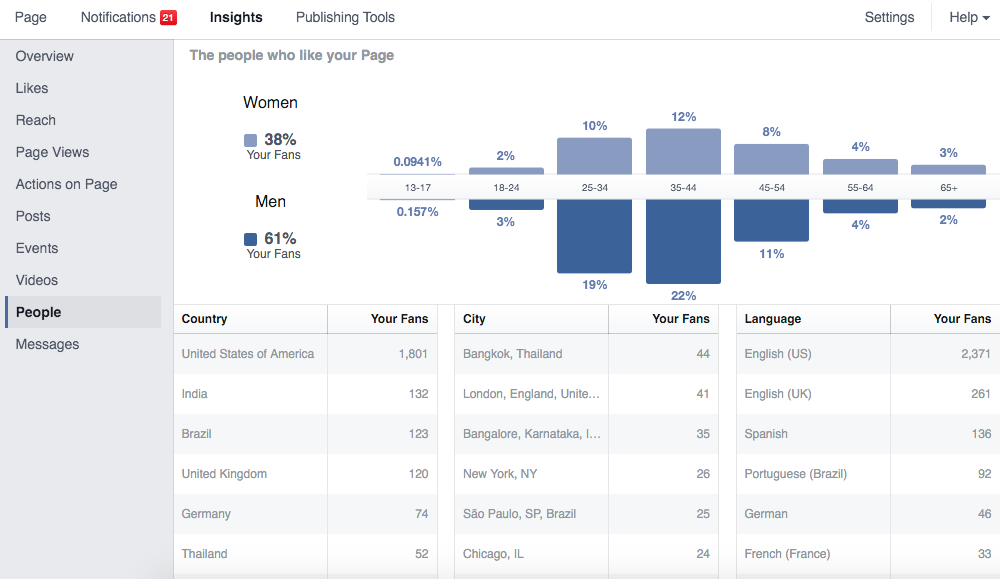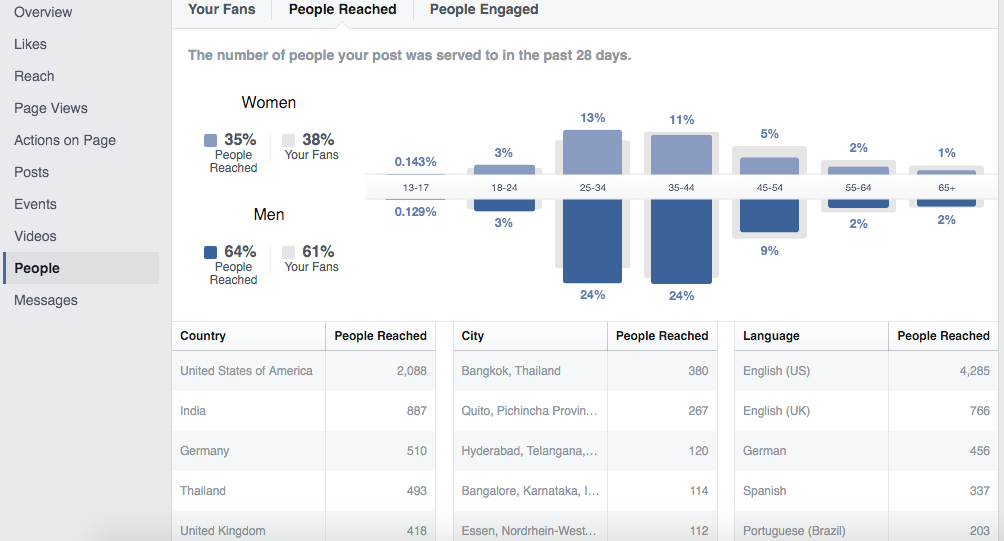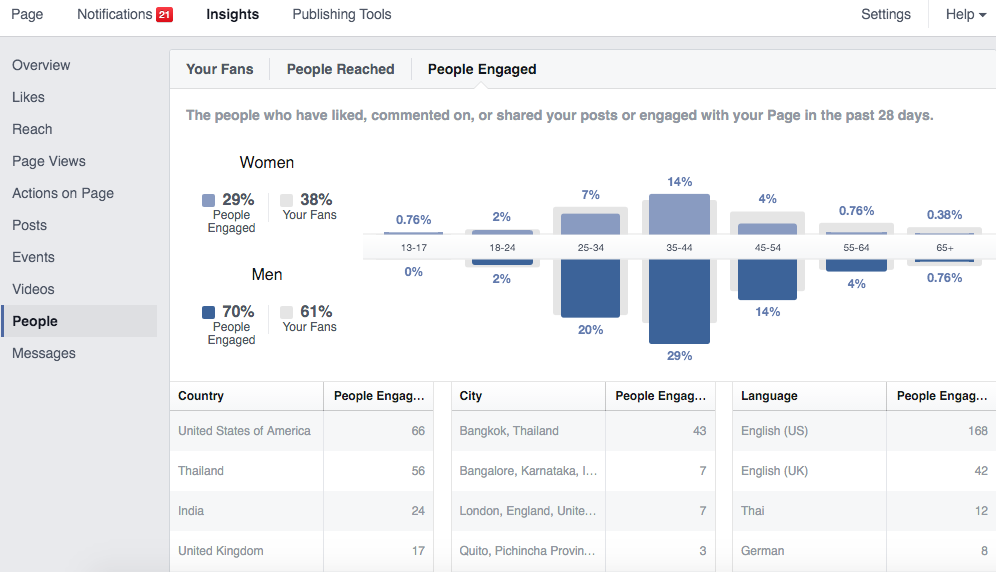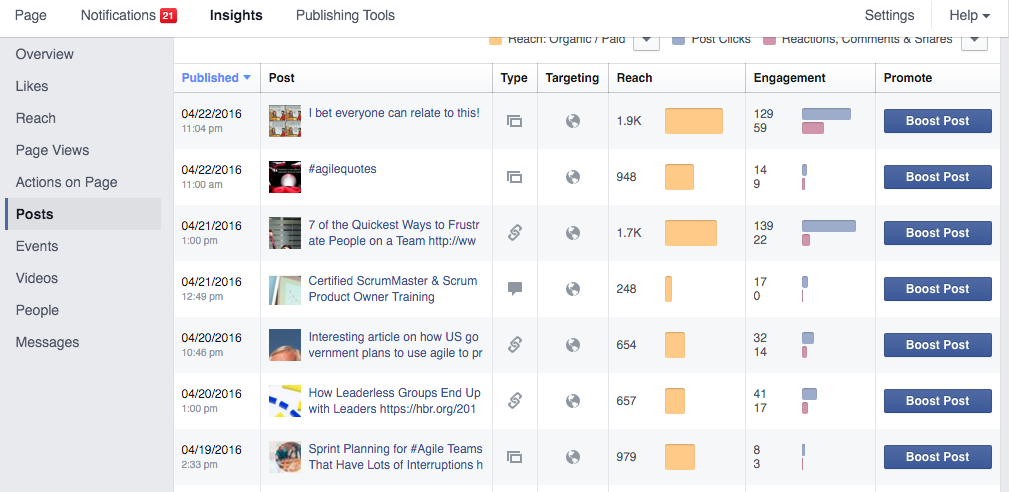May 21, 2024
Informing Facebook Advertising with Page Insights
By Megalytic Staff - May 10, 2016
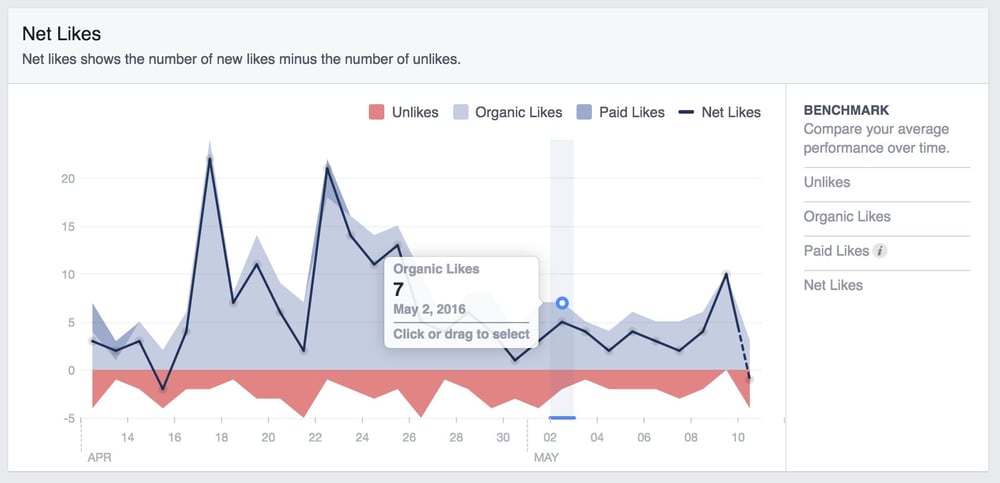
Learning from Current Fans
There are a number of ways that people become fans of a brand. Perhaps the like was acquired when a friend shared your page, or because it appeared in an ad. Maybe they actively researched your brand on Facebook or visited your page after being on your website. Your current fans have chosen to like your Page for a reason, and while those reasons are often as diverse as your customers themselves, there is much we can learn by analyzing these followers. By looking at the demographics of existing fans, you can see how well they match up with your desired characteristics and if there are new potential groups you could be reaching.
To see this data, navigate to your brand Page from a Facebook account that has been assigned a Page role such as Admin, Editor, Moderator, Advertiser, or Analyst. Next, select Insights from the top navigation bar. Once there, choose People from the left sidebar. You’ll land by default on the Your Fans section, showing gender, age, and geography for the people who currently like your Page.
This example shows data from a Page for a software development training company. It’s clear that men 35-44 make up the largest demographic category, with men 25-34 close behind. However, we can also see that a sizeable portion of the audience is made up of women 35-44 and 25-34.
With this insight, we can correlate our Facebook ad targeting accordingly. When setting up audiences, we can likely leave out the 18-24 age bracket, as those people are more likely to be in or just out of college. These individuals, in general, would seem less likely to be looking for continuing education courses. Similarly, those in older age brackets (55+) are less likely to be in the software development industry.
Considering this information, our final ad targeting should likely focus on individuals 25-54. While men make up the primary current audience, we should also target women working in the software development industry, as there is clear demonstrated interest across genders, and women comprise a rapidly growing sector in technology.
Unfortunately, Insights data only breaks down age by 10-year brackets, (e.g. 25-34), while the Facebook Advertising system allows you to target by precise age points. If you want to evaluate your ad performance with age brackets more specific than 10-year segments, you’ll need to set up separate ad sets by age and conduct tests. In addition, we can see data about the geographic locations of fans. While you may want to take some locations with a grain of salt, making allowances for what may appear to be foreign spam profiles, you should consider possible targets outside your default regions. For example, while this brand primarily targets the USA, several people like the page from London, indicating an audience, and potentially customers, in England.
Looking at Who You Reached
The next tab in the People report shows People Reached, telling you demographics of the people who saw your posts, whether through organic News Feed appearance or via ads. This group differs from your fans because they were only exposed to your brand ads, without necessarily having actively engaged with the brand in any way. The individuals here are less aware of you than those who comprise your fan base. While this data can be skewed by existing ad targeting, it can help to show you another picture of people who may be becoming aware of your brand, possibly for the first time.
Looking at this information, you may be able to identify holes in your reach, picking out demographic categories who are not heavily exposed to your messaging. For example, we notice that a smaller percentage of individuals ages 45-54 are actually reached by advertising than have chosen to like the Page. Considering that 45-54-year-olds tend to have greater active interest in the brand, if we want to maximize our reach to this demographic, we should focus some ad spend toward that age range.
Seeing Who Engaged
The final tab to the right shows what categories of individuals actually chose to interact with your Page. Engagement includes likes, shares, comments, or clicks on posts. This data provides the most accurate window into which people are most likely to actually be potential customers, as they’re taking an extra step beyond simply looking at posts.
Here, we see men 35-44 as a much stronger top category, with men 25-34 next, aligning with the data from the Your Fans report. Also as reflected by the fan base, there is a strong showing of women, with the highest interaction from the 35-44 age group.
Understanding how age groups engage with content can be extremely useful. One of the best opportunities to expand overall reach is when others share our content. If these demographics are more likely to share our content, then it increases the size of the audience we are reaching exponentially. Targeting the age ranges most likely to help spread our content is an excellent way to leverage this behavior for more exposure.
Evaluating Content for Advertising Potential
While the demographics of Fans indicate those with an active interest in the brand and its offerings, engagement helps us gauge interest in specific content. The extent of the brand’s reach and the growth of the active fan base rely on the ability to create content that connects.
Your Page Insights section tells you how well your posts have performed in driving reach and engagement, helping to tell you understand what types of content your audience finds most interesting.
Go to the Posts section of Insights to see data on recent post performance. Here, you can see how many people you reached, with organic reach helping to measure how likely people may have been to share and like your content to exposing it to others. In addition, the engagement count breaks down into Clicks (blue) in addition to Reactions, Comments, and Shares (red).
In the example above, we see that two especially popular pieces of content were a cartoon and a link to an article. We can also note the wording that drove the most engagement. For instance, an article that implied a list of quick points (“7 Ways to Frustrate People on a Team”) received much more attention than other articles posted.
Based on the data we glean in this report, we can plan for content to include in our ads. For instance, we see that a web development-related cartoon drives a high click volume and other interactions. In many cases a lighthearted approach can help draw people in, potentially leading to a more serious consideration of your brand. Judging by the performance of the initial cartoon, we may want to test additional cartoons and comics to see if this is a pattern. If cartoons continue to resonate with our base, it might be worth including a cartoon, perhaps a custom comic with a branded message, in an ad.
Conclusion
Facebook Insights allows for the measurement of both exposure and action. With this information you can learn who you need to reach and evaluate what most commonly drives them to interact. Through both demographic data and information about content performance, you can use this data to help you to refine your Facebook ad targeting. In turn, you’ll be able to better segment your potential audience and use past performance to brainstorm future messaging to reach them.
In addition to looking at your paid ad performance, take time to review and analyze your Facebook Insights data regularly. You may be surprised to find new potential for expanding your demographic target or identifying new types of content that appeal to your audience. In either case, you have the tools to grow your potential customer base and drive more meaningful engagements.

